C1 C2 C3 C4 C5 C6 C7 C8 C9 C10
C1 1.000
C2 0.274 1.000
C3 -0.134 -0.269 1.000
C4 0.201 -0.153 0.075 1.000
C5 -0.129 -0.166 0.278 -0.011 1.000
C6 -0.095 0.280 -0.348 -0.378 -0.009 1.000
C7 0.171 -0.122 0.288 0.086 0.193 0.002 1.000
C8 0.219 0.242 -0.380 -0.227 -0.551 0.324 -0.082 1.000
C9 0.518 0.238 0.002 0.082 -0.015 0.304 0.347 -0.013 1.000
C10 0.299 0.568 0.165 -0.122 -0.106 -0.169 0.243 0.014 0.352 1.000
This is an example of a random correlation matrix. These are common in scientific studies. There are two triangles in a correlation matrix
but that would be redundant to add since they are mirror images of one another.
Monday, July 27, 2009
Correlation matrix
Sunday, July 26, 2009
star plot
stem and leaf plots
Box Plot

I got this box-plot from http://www.krisweb.com/stream/habtyp.htm. I know it is difficult to see here but the explanation is the maximum and minimum depths of a variety of streams in the area in order to be suitable habitats for certain species of fish.
Histogram
Parallel coordinate graph

 The airplanes will be represented with three broken lines connecting the X, Y, Z positions of each airplane. In addition, a fourth parallel coordinate representing time is provided. (We will show only three times associated with the initial time and the times the red airplane appears to cross the trajectories of the other two.) Y-axis values represent some physical position and time measures. I found this at http://www.caip.rutgers.edu/~peskin/epriRpt/ParallelCoords.html
The airplanes will be represented with three broken lines connecting the X, Y, Z positions of each airplane. In addition, a fourth parallel coordinate representing time is provided. (We will show only three times associated with the initial time and the times the red airplane appears to cross the trajectories of the other two.) Y-axis values represent some physical position and time measures. I found this at http://www.caip.rutgers.edu/~peskin/epriRpt/ParallelCoords.htmltriangular plot
Windrose
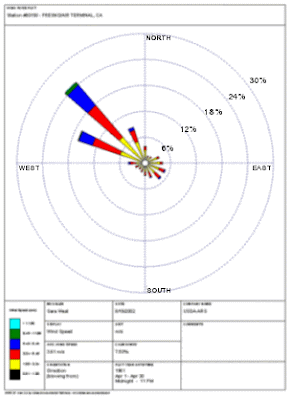
This Image is from Fresno, Ca airport. It is obvious that the winds are prevailing strongly to the NW. In the image below however, LeGuardia airport, the wind directions seem to be all over the place. They do prevail a bit to the south but otherwise a huge range of wind directions.
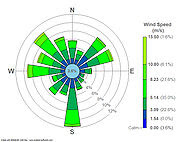
This is a windrose is from LeGuardia airport
Climograph
scatterplot
Population profile
Index Value plot
Accumulative line graph or Lorenz curve
bilateral graph
Nominal area choropleth
unstandardized choropleth
Standardized Choropleth map
Univariate Choropleth
Bivariate choropleth map
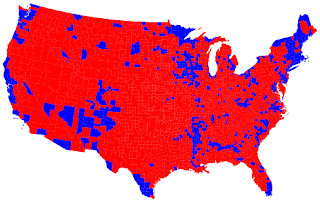
This image is a political pole by county on republican vs. democrat. Two color schemes to represent opposite data
http://www.nytimes.com/interactive/2008/09/04/business/20080907-metrics-graphic.html
This link is a really cool interactive bivariate choropleth on world spending.
unclassed choropleth
classed choropleth
Monday, July 20, 2009
Range graded proportional circle map
DOQQ (Digital Orthographic Quarter-Quad)
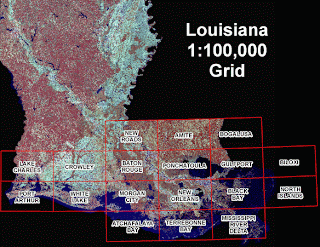
I found this DOQQ at www.lacoast.gov/maps/2005doqq/. This is an aerial photograph take of Louisiana after a hurricane. This is likely to assess the damage in quadrants.
DEM

This is a DEM of Mt. Rainier that I found at www.highend3d.com/maya/
DLG

This is a DRG map that I found at vis.lbl.gov/.../
DRG
Isopleths
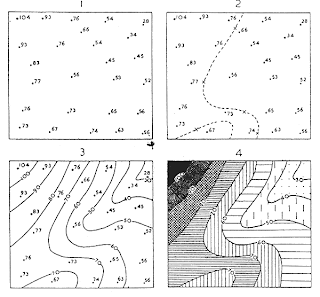
I got this tutorial map at www.fao.org/DOCREP/
Isopach

I got this image from www.kgs.ku.edu/
Isohyets
Isotachs

I found this map at www4.ncsu.edu/~nwsfo/
Isobars
LIDAR image
Doppler radar
Black and white Aerial photo

I found this image at nature.sbc.edu/
Infrared aerial photo (deforestation)
Infrared aerial photo
cartographic animation
 This animation shows change in global climate. The animation stopped when I captured the image. This extremely overly long link shows many animations dealing with global climate.
This animation shows change in global climate. The animation stopped when I captured the image. This extremely overly long link shows many animations dealing with global climate.http://images.google.com/imgres?imgurl=http://uwacadweb.uwyo.edu/JSHINKER/animations/global/gifs/nlwrs_web.gif&imgrefurl=http://uwacadweb.uwyo.edu/JSHINKER/animations/global/&usg=__QIbXN5ZVG3eE7-ogzERnV2Be0-8=&h=458&w=674&sz=224&hl=en&start=15&um=1&tbnid=L3lAljKs9w2rTM:&tbnh=94&tbnw=138&prev=/images%3Fq%3Dcartographic%2Banimations%26hl%3Den%26rlz%3D1G1GGLQ_ENUS335%26sa%3DG%26um%3D1
statistical map
Cartograms
Flow map
Isoline maps
Subscribe to:
Comments (Atom)





























